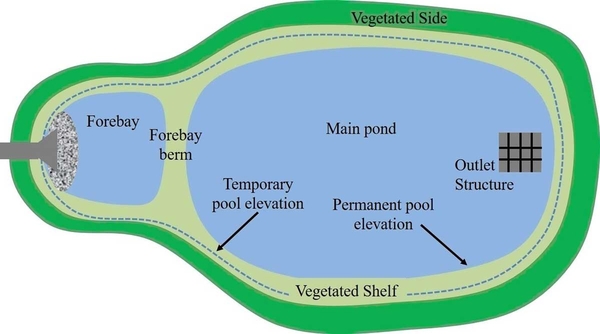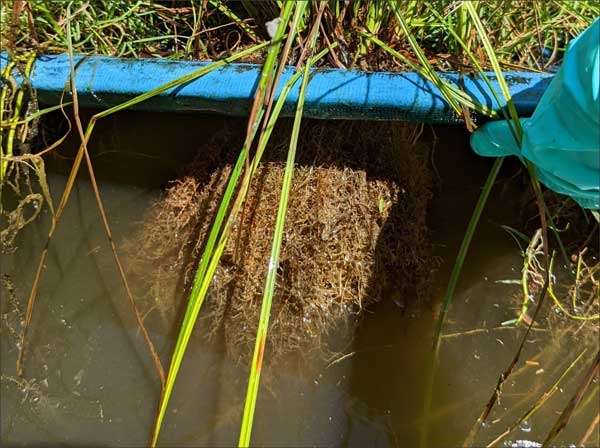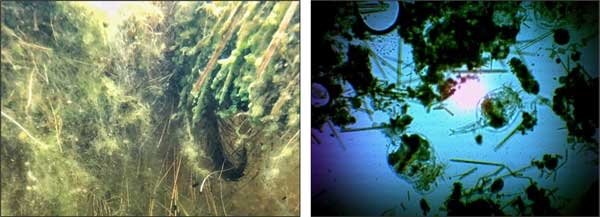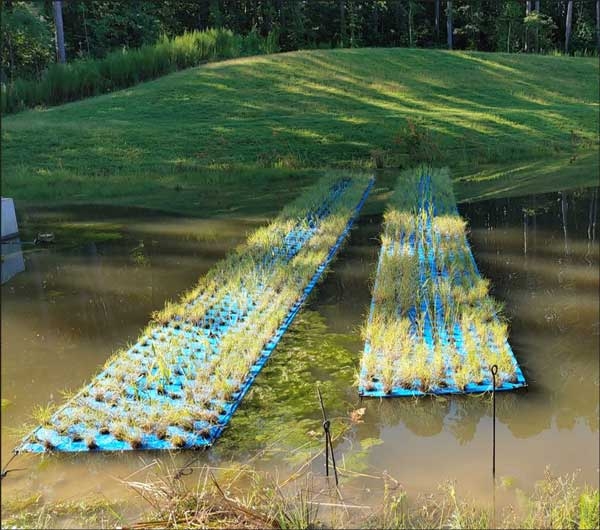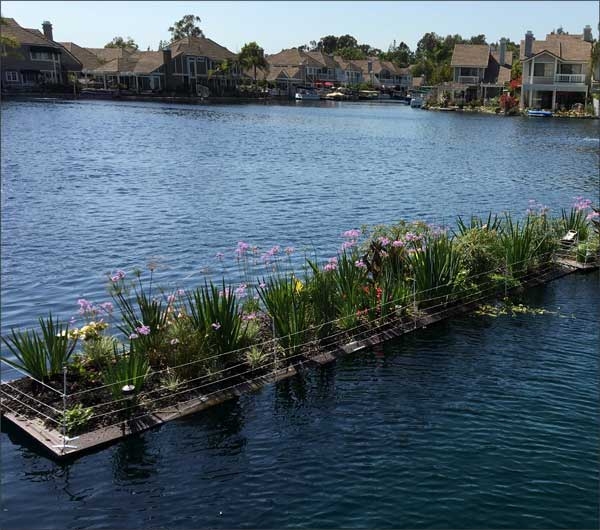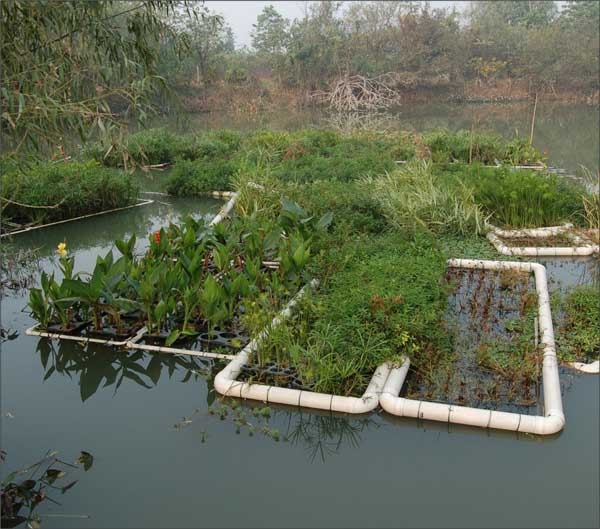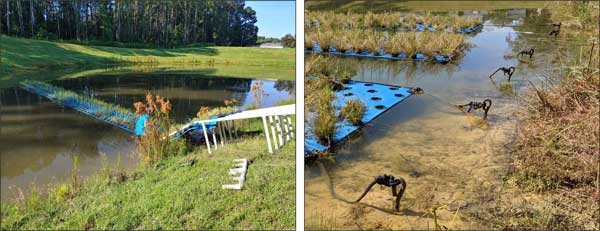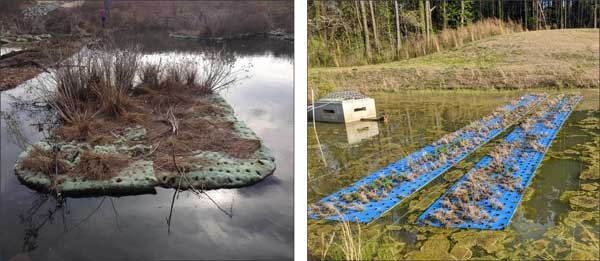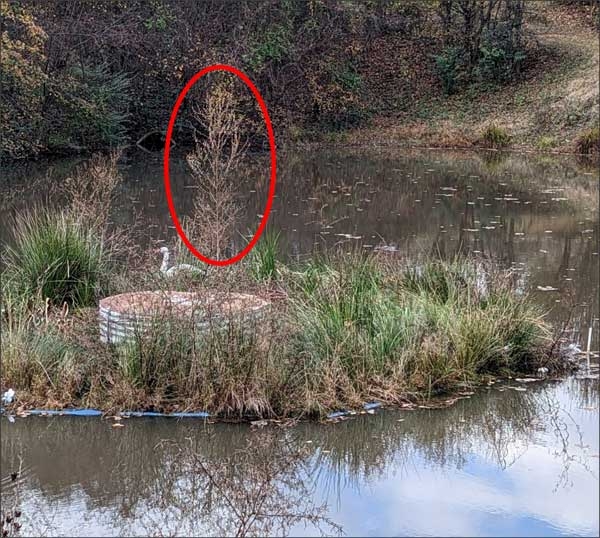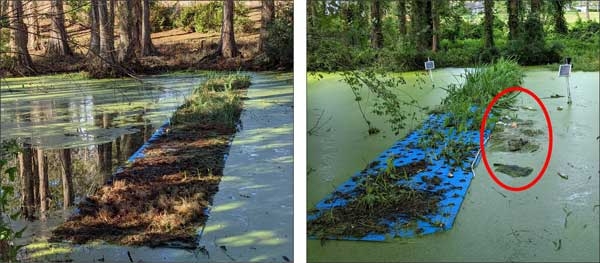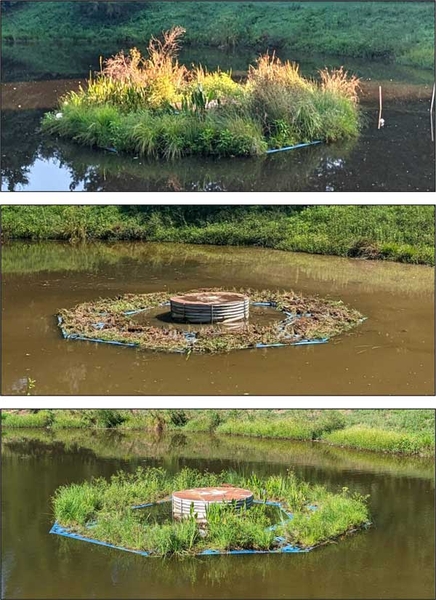Introduction
Stormwater retention ponds, also known as wet ponds, are among the oldest and most common stormwater control measures (SCMs) used in North Carolina. Wet ponds were first implemented for flood management, but their purpose evolved to include treating stormwater runoff to improve water quality. Wet ponds (Figure 1) are designed to maintain a permanent pool of water and have additional capacity to capture runoff produced by a design storm (1 to 1.5 inches in North Carolina), also known as a water quality event. The runoff is then released over two to five days through an outlet typically composed of a riser structure and drawdown orifice. Wet ponds are also required to have a pretreatment forebay, an aquatic shelf that is 6 feet wide, and an outlet structure that is placed to minimize the risk of short-circuiting (NCDEQ 2020). These design elements were implemented to promote pollutant removal; they are less common in ponds built before design guidelines changed in the first decade of this century. Because many older wet ponds have failed to provide adequate water treatment necessary to meet current state water quality standards, several wet pond retrofits have been developed over the past few decades to improve their treatment capability. The most common wet pond retrofit in North Carolina is the floating treatment wetland (FTW).
Floating Treatment Wetlands
What Are Floating Treatment Wetlands?
FTWs are a popular retrofit option for wet ponds that are underperforming as a result of outdated or undersized designs. FTWs are used in the United States and many other places throughout the world, including New Zealand, China, India, and Germany. They are known also as floating wetland islands (FWIs), artificial floating islands (AFIs), constructed floating wetlands (CFWs), and ecological floating beds (EFBs) (Shen et al. 2021). Figure 2 depicts a schematic of the primary FTW design components and treatment mechanisms. The FTW is composed of a buoyant mat planted with wetland vegetation whose roots grow down into the water column. The mat is anchored either to the bottom of the pond or to the banks, when possible. The root systems provide a biologically active surface area to which microbial communities can adhere and grow (Figure 3 and Figure 4). The combination of the root system and attached microorganisms is commonly referred to as the root-biofilm network (Headley and Tanner 2012). This network presumably enhances water quality treatment via gross filtration and pollutant entrapment as runoff flows through the root system. Entrapped pollutants may then aggregate into flocs (which settle to the pond bottom) or may be transformed by the microbial communities into forms that can easily be taken up by the plants.
Why Use Floating Treatment Wetlands?
FTWs have many advantages besides improved pollutant removal. Because FTW mats float on the surface, they do not diminish the storage capacity or peak flow attenuation capacity of the pond. FTWs rise and fall with the changing water level, thus eliminating the risk of plant loss due to prolonged inundation that may occur in traditional constructed wetlands. Another benefit of FTWs is that they provide a diverse wildlife habitat that may support waterfowl, amphibians, fish, and aquatic and terrestrial macroinvertebrates. Moreover, FTWs can be designed with various shapes, sizes, and plant species to enhance the pond’s aesthetic value. As an additional incentive, the North Carolina Stormwater Control Measure Credit Document awards total nitrogen (TN) and total phosphorus (TP) credits for retrofitting a stormwater wet pond with FTWs (Table 1). To receive the retrofit credit, FTWs must comprise at least 5% of the wet pond’s permanent pool surface area. The North Carolina Department of Environmental Quality (NCDEQ) created the credit document to establish how well SCMs remove nutrients and to assign effluent concentrations and runoff reduction values to every practice approved by the state.
Adapted from NCDEQ 2018.
North Carolina Floating Treatment Wetland Installations
North Carolina State University and local partners have installed and monitored FTWs in four wet ponds in North Carolina as part of two studies conducted between 2008 and 2011 (Winston et al. 2013) and between 2020 and 2022 (Landon 2023) (Table 2 and Figure 5). Table 3 presents a summary of water quality results from the four wet ponds pre- and post-retrofit. The three ponds monitored pre-retrofit had average removal efficiencies (REs) of 41% TN, 43% TP, and 66% total suspended solids (TSS) between the inlet and outlet. Post-retrofit, those ponds removed an average of 63% TN, 58% TP, and 73% TSS. A fourth pond monitored only post-retrofit removed 42% TN, 77% TP, and 89% TSS. A noticeable improvement in water quality was observed across all sites post-retrofit, indicating that the FTWs introduced and enhanced pollutant removal mechanisms, though not definitively. The general FTW installation and maintenance recommendations described herein were based on the results and observations recorded during these two studies.
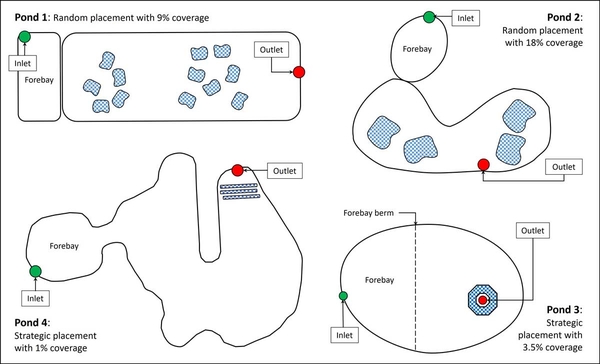
Figure 5. FTW designs in four North Carolina wet pond retrofit studies. The checkered blue shapes indicate approximate FTW positioning. Pond 1 contains 12 FTWs in body of pond. Pond 2 contains 4 FTWs in body of pond. Pond 3 contains FTWs encircling pond outlet. Pond 4 contains three linear FTWs placed perpendicularly just upstream of outlet.
Floating Treatment Wetlands Design Criteria, Installation, and Maintenance
Wet Pond Requirements
When retrofitting a wet pond with FTWs, it is essential to first ensure the pond is easily accessible to installation and maintenance personnel. FTWs should not be installed in ponds with normal pool depths of less than 3 feet to avoid the risk of wetland plants rooting into the benthic layer. When FTW plants become rooted in the benthic layer, the mats are no longer free to rise with the water level, and plants may become submerged and killed. Areas in ponds that are deeper than 6 feet are also poor locations for FTWs because runoff can easily flow underneath the FTW root system and bypass treatment.
FTW Design Criteria
Once a wet pond suitable for retrofitting has been identified, you must decide whether to hire a commercial vendor or build the FTW yourself. Many commercial vendors have well-tested FTW products and experienced personnel to aid in the design and installation process. Some of the most popular commercial products include Beemats™ Floating Wetlands (Beemats LLC) (Figure 6), BioHaven® Floating Islands (Floating Island International Inc.) (Figure 7), and Biomatrix Floating Ecosystems (Biomatrix Water) (Figure 8), all of which are proprietary products that come preassembled and ready for installation. If your budget is limited, you may choose the do-it-yourself (DIY) option, an example of which is shown in Figure 9. All FTWs must adhere to several specific design criteria. Table 4 presents a summary of FTW design components and recommendations.
Mats and Growth Media
The mat provides structural support and buoyancy for the FTW. The mat material must be durable (for example, resistant to ultraviolet light), nontoxic, and buoyant enough to support the weight of full-grown wetland plants. These structures come in a variety of forms, including mats with pre-cut planting holes that allow vegetation to grow directly in the water (that is, without soil), for example, Beemats™ Floating Wetlands; permeable mats that allow plants to grow through them into the water column, for example, BioHaven® Floating Islands and Biomatrix Floating Ecosystems; and rigid, buoyant DIY frames that hold plants suspended within them. Common materials used for buoyancy and structure include polyethylene or polystyrene foam mats, plastic pipes or tubes (for example, PVC), bamboo, and stainless steel.
| Design Component | Recommendation |
|---|---|
| Mat material |
|
| Planting media* |
|
| Vegetation |
|
| Planting density |
|
| Mat surface area coverage |
|
| Mat placement |
|
| Anchoring |
|
*Plant plugs may also be installed without soil media to minimize the risk of nutrient leaching (adapted from NCDEQ 2020 and Borne et al. 2015). ↲
Soil or other potting media may be included to facilitate plant growth or promote pollutant adsorption. Although potting media can facilitate rapid plant growth, it may become a source of pollution if nutrients leach into the water. Alternatively, to improve nutrient removal, you may install plugs in aerator pots with no potting media in FTW mats so they can take up nutrients directly from the water column.
Plant Selection
FTWs should include a diverse mixture of native wetland plant species whose roots are dense, fibrous, and capable of growing 2 to 3 feet long. Roots with these characteristics provide the most surface area for biofilm growth, nutrient uptake, and filtration. Using multiple species minimizes the risk of plant loss, as some species may adapt better to the water conditions (chemical and physical parameters) of a given pond than others. Some species may also be more susceptible to disease or predation by wildlife, such as waterfowl and turtles. In addition, planting FTWs with multiple species has shown evidence of increased plant growth and nutrient uptake compared to planting with a single species (Garcia Chance et al. 2018; Messer et al. 2022). Table 5 contains a list of recommended plant species that have been used in FTW field studies in North Carolina. Detailed plant descriptions and images are available in the North Carolina Extension Gardener Plant Toolbox. Plant density should be about one plant per 2 square feet, with at least 85% plant coverage maintained on the FTWs.
Pond Surface Coverage and Placement
FTW surface area coverage and placement are two key design parameters that influence water quality treatment (Winston et al. 2013; Lane et al. 2016; Xavier et al. 2018). Surface area coverage represents the portion of the pond where FTWs are present, while placement affects runoff contact with FTWs Avoid covering more than 50% of the pond’s surface with FTWs to prevent depletion of dissolved oxygen (DO) in the water column (Borne et al. 2015). When FTWs are randomly placed in a wet pond for aesthetic purposes, the FTW mat area should cover at least 20% of the wet pond’s permanent pool surface area for significant water quality improvement (Winston et al. 2013). However, random placement is not typically recommended when the goal is to optimize water quality treatment because runoff can easily flow around the FTWs and leave the pond untreated. Instead, FTWs should be placed so that they span the full width of the pond, perpendicular to the direction of flow. Full-width placement ensures that runoff will flow through the FTW root network before exiting the pond, thus maximizing treatment potential. This placement can be achieved using linear FTWs or by tethering multiple islands together to form a chain (Figure 10).
Two strategic placement options are recommended for FTWs: either (1) placing FTWs directly downstream of the forebay area in the main body of the pond to slow and dissipate influent runoff or (2) placing FTWs shortly upstream of the outlet structure (typically within 15 feet) to provide final water quality polishing just before stormwater is discharged. In both options, FTWs should be arranged to span the full width of the flow path in the given section of the pond. Strategic FTW placement enables this retrofit to significantly improve water quality even at low surface-coverage rates (less than 5%). For example, data from Pond 3 (Figure 5) indicated that water quality treatment improved when FTWs covering about 3.5% of the pond’s surface encircled the outlet structure (Landon 2023). More research is needed to determine the optimal FTW arrangement.
Installation
To promote successful plant establishment, FTWs should ideally be installed between spring and midsummer (roughly April through July in North Carolina). If installed too late in the growing season, the plants may not have time to fully establish before winter; juvenile plant plugs are less likely to survive cold temperatures and icing. If plant plugs are sourced from a location with a different climate or grown indoors, place them outside to acclimate for at least a week before installation. Planting vegetation before deploying the FTW on the pond is recommended, especially if the floating mats are not buoyant enough to support the weight of a person. Mats can be planted either on the flat banks or in the shallow waters of the vegetated shelf. Long, linear mats may be planted using a makeshift ramp system for optimized efficiency, such as those used by Beemats™ (Figure 10). If the FTWs are strong enough to support the weight of at least one person (such as the BioHaven® Floating Islands), it may be easier to plant after deployment (Figure 11). When planting on the water, start from the innermost rows and work outward toward the perimeter to avoid damaging plants.
If planting on the water, installers can use paddle boards or small boats, depending on the depth and other site constraints. Though waders may be used, wading is not highly recommended, as it stirs up benthic sediments and causes pollutants to become resuspended. Commercial suppliers of FTWs may offer installation services; stormwater professionals and SCM maintenance personnel also can install them. Alternatively, you can recruit citizen volunteers to help with installation, which offers the additional benefit of public education on stormwater management. Once installed, anchor islands in place. Anchoring options include tethered cinder blocks, boat anchors, or helical anchors, which can be screwed into the earth and provide the most stability. Consider anchoring FTWs to the shoreline when practical (Figure 10) and connecting anchors via locking carabiners to provide easy access.
| Plant Species | USDA Plant Hardiness Zones | Description and Field Notes |
|---|---|---|
| Big bluestem [a] Andropogon gerardii | Zones 4–9 |
|
| Tussock sedge [a, b, +] Carex stricta | Zones 4–8 |
|
| Soft rush [a, b, +] Juncus effusus | Zones 1–11 |
|
| Seashore paspalum [b] Paspalum vaginatum | Zones 8–11 |
|
| Saltmeadow cordgrass [b, +] Spartina patens | Zones 4–10 |
|
| Prairie cordgrass [a, +] Spartina pectinata | Zones 4–9 |
|
| Golden canna [b] Canna flaccida | Zones 8–10 |
|
| Marsh hibiscus [a, +] Hibiscus moscheutos | Zones 5–9 |
|
| Southern blue flag iris [b, +] Iris virginica | Zones 5–9 |
|
| Arrow arum [a] Peltandra virginica | Zones 5–9 |
|
| Pickerelweed [a, b] Pontederia cordata | Zones 3–10 |
|
| Bulltongue arrowhead [b] Sagittaria lancifolia | Zones 6–11 |
|
[a] Indicates plants used in Ponds 1 and 2 (Winston et al. 2013); [b] indicates plants used in Ponds 3 and 4 (Landon 2023); [+] indicates plants that thrived and had the best growth in terms of shoot/root biomass production and root length during the studies. ↲
After installation, ensure that sufficient predator protection is in place around the structures. During the first growing season, turtles and other predators such as Canada geese (Branta canadensis) and other waterfowl pose a major threat to plant establishment, particularly young plant plugs (Figure 12). Fencing is one of the most popular means of preventing plant predation. When possible, install fencing around the perimeter of the FTWs to deter predators from climbing onto the mats from the water or shoreline (Figure 11). Standard fencing options include chicken wire, deer fencing, or natural degradable fibers such as jute twine held by wooden stakes.
When using wire that is difficult to see, place pieces of reflective tape intermittently around the fencing to ensure that wildlife can see it and not become entangled. You can also place reflective pinwheels around or in the FTWs. The motion of the pinwheels provides enough sound and reflective light to deter wildlife (Figure 12). Pinwheels can be used in conjunction with fencing or by themselves. Other protection options include predator decoys (for example, fake swans or wolves) (Figure 12), spraying plants with nontoxic repellents, or hiring working dogs to chase away geese during the first few weeks after installation. Once plants are well established, remove fencing and other protective devices to keep this material from becoming litter. To minimize plant loss, choose plant species that are less likely to appeal to predators. Table 5 includes species that thrived in North Carolina installations.
Maintenance
Inspection and Remedial Actions
Proper maintenance of FTWs is vital to ensuring sustained water quality treatment and pleasing aesthetics (Blecken et al. 2017). Maintenance needs are initially high following installation but become less intensive after the first growing season. In the first few days after installation, daily visits are recommended to address any issues with the FTWs, such as poor anchoring or plant predation. Additional protection measures, such as those discussed in the previous section, should be quickly implemented if plants are being eaten or removed. Site visits can be conducted less frequently (for example, biweekly) once predation is under control. If more than 15% of plants are lost to predation or cold weather, replant FTWs using species that thrived.
After the first growing season, inspect FTWs about every three months to ensure they are functioning as intended. Confirm that FTWs remain securely anchored (Figure 13) and that the plants are healthy; if plant losses result in less than 85% coverage, gaps in FTWs should be replanted (Figure 14). Remove volunteer invasive species if necessary to preserve aesthetics and ecological integrity. Remove any trees growing on the FTWs as soon as possible because their weight will quickly sink the floating mats and inundate vegetation (Figure 15). Consider applying aquatic formulations of glyphosate to the base of cut trees to prevent regrowth, as described in Maintenance of Stormwater Wetlands and Wet Ponds. Remove any trash and organic debris that collect on and along the FTWs to maintain aesthetics and healthy plant growth (Figure 16). Inspect FTWs for damage after major storm events with heavy rain and high wind speeds (Figure 17).
Harvesting Vegetation
Harvesting vegetation from FTWs has been recommended to avoid reintroducing nutrients to the water column upon plant senescence (Zhou and Wang 2010). Moreover, harvesting permanently removes pollutants from the wet pond–FTW system (White 2021). Harvesting may include removal of entire plants and replanting, cutting back plant roots and shoots close to the root ball, or simply trimming plant biomass above the mat. Above-mat harvesting is recommended, particularly in nutrient-rich wet ponds, where shoots have been observed to store four to six times more nutrient mass than in the root zone (Landon 2023). Above-mat plant biomass can be removed with hedge-cutting shears while FTWs are deployed in the water, using a paddleboard or small boat for access.
If the majority of plant biomass (and thus captured pollutants) is below the mat, it may be preferable to harvest entire plants or cut roots and shoots (White and Cousins 2013). Note that cutting roots temporarily dampens treatment via gross filtration and microbial transformations provided by the root-biofilm network. An example harvest of both shoots and roots conducted in Pond 3 is shown in Figure 18 and Figure 19. When cutting shoots and roots, remove FTWs from the water before trimming. Also work on land when removing entire plants from FTWs to avoid dislodging captured pollutants from the root-biofilm network and releasing them back into the water.
Timing of harvest will vary, depending on the harvesting method and goal. Harvesting in late summer through early fall, before plant senescence begins, is recommended to prevent reintroducing pollutants to the water column. Alternatively, if the purpose of harvesting is to maximize plant uptake rates, cut plants back in midsummer, when plant growth rates are highest (Wang et al. 2014). Harvested plant material may be composted.
Summary
Floating treatment wetlands can improve water quality treatment in a variety of stormwater retention ponds. FTWs are a good retrofit option for wet ponds that have outdated designs, are undersized, or have been neglected over the years. When designing FTWs, consider the optimal mat material, potting media, wetland plant species, planting density, and anchoring system. In addition, carefully determine FTW location within the wet pond and the fraction of pond area that the structures should cover. If placed randomly within the pond, FTWs should cover at least 20% of the surface area.
Reduced surface coverage (for example, 3% to 5%) is acceptable if FTWs are strategically placed to span the full width of the pond’s flow path, either directly downstream of the forebay or just upstream of the outlet. After installation, ensure protection from predators. Closely monitor FTWs through the first growing season to ensure successful plant establishment. Maintenance needs are minimal thereafter. Conduct quarterly inspections to confirm that FTWs are securely anchored and to remove invasive plants, trash, and organic debris. With proper design and maintenance, FTWs can provide a relatively low-cost retrofit option for improving water quality treatment, wildlife habitat, and aesthetics in stormwater retention ponds.
References
Blecken, G. T., W. F. Hunt III, A. M. Al-Rubaei, M. Viklander, and W. G. Lord. 2017. “Stormwater Control Measure (SCM) Maintenance Considerations to Ensure Designed Functionality.” Urban Water Journal 14 (3): 278–290. ↲
Borne, K. E., E. A. Fassman-Beck, R. J. Winston, W. F. Hunt, and C. C. Tanner. 2015. “Implementation and Maintenance of Floating Treatment Wetlands for Urban Stormwater Management.” Journal of Environmental Engineering 141 (11): 04015030. ↲
Garcia Chance, L. M., and S. A. White. 2018. “Aeration and Plant Coverage Influence Floating Treatment Wetland Remediation Efficacy.” Ecological Engineering 122: 62–68. ↲
Headley, T. R., and C. C. Tanner. 2012. “Constructed Wetlands with Floating Emergent Macrophytes: An Innovative Stormwater Treatment Technology.” Critical Reviews in Environmental Science and Technology 42 (21): 2261–2310. ↲
Landon, M. E. 2023. “Wetlands Monitoring and Adaptation in Stormwater: Optimizing Floating Treatment Wetland Design and Leveraging Citizen Science for Sustainable Natural Wetland Monitoring.” Master’s Thesis, North Carolina State University. ↲
Lane, S., D. Sample, A. Lazur, R. Winston, C. Streb, D. Ferrier, et al. 2016. Recommendations of the Expert Panel to Define Removal Rates for Floating Treatment Wetlands in Existing Wet Ponds. Chesapeake Stormwater Network and Chesapeake Research Consortium. Pennsylvania. ↲
Messer, T. L., D. N. Miller, H. Little, and K. Oathout. 2022. “Nitrate-N Removal Rate Variabilities in Floating Treatment Wetland Mesocosms with Diverse Planting and Carbon Amendment Designs.” Ecological Engineering 174: 106444. ↲
NCDEQ. 2018. Stormwater Control Measure Credit Document. In NCDEQ Stormwater Design Manual. North Carolina Department of Environmental Quality. ↲
NCDEQ. 2020. C-3. Wet Pond. In NCDEQ Stormwater Design Manual. North Carolina Department of Environmental Quality. ↲
Shen, S., X. Li, and X. Lu. 2021. "Recent Developments and Applications of Floating Treatment Wetlands for Treating Different Source Waters: A Review.” Environmental Science and Pollution Research 28: 62061–84. ↲
Wang, C. Y., D. J. Sample, and C. Bell. 2014. “Vegetation Effects on Floating Treatment Wetland Nutrient Removal and Harvesting Strategies in Urban Stormwater Ponds.” Science of The Total Environment 499: 384–393. ↲
White, S. A., and M. M. Cousins. 2013. “Floating Treatment Wetland Aided Remediation of Nitrogen and Phosphorus from Simulated Stormwater Runoff.” Ecological Engineering 61 (3): 207–215. ↲
White, S. A. 2021. “Plant Nutrient Uptake in Full-Scale Floating Treatment Wetlands in a Florida Stormwater Pond: 2016–2020.” Water 13 (4): 569. ↲
Winston, R. J., W. F. Hunt, S. G. Kennedy, L. S. Merriman, J. Chandler, and D. Brown. 2013. “Evaluation of Floating Treatment Wetlands as Retrofits to Existing Stormwater Retention Ponds.” Ecological Engineering 54: 254–265. ↲
Xavier, M. L. M, J. G. Janzen, and H. Nepf. 2018. “Numerical Modeling Study to Compare the Nutrient Removal Potential of Different Floating Treatment Island Configurations in a Stormwater Pond.” Ecological Engineering 111: 78–84. ↲
Zhou, X., and G. Wang. 2010. “Nutrient Concentration Variations during Oenanthe javanica Growth and Decay in the Ecological Floating Bed System.” Journal of Environmental Sciences 22 (11): 1710–1717. ↲
Additional Resource
Hunt, W. F., and W. G. Lord. 2006. Maintenance of Stormwater Wetlands and Wet Ponds. Urban Waterways Series. AGW-588-07. Raleigh, NC: North Carolina Cooperative Extension.
Publication date: Oct. 9, 2024
AG-588-29
N.C. Cooperative Extension prohibits discrimination and harassment regardless of age, color, disability, family and marital status, gender identity, national origin, political beliefs, race, religion, sex (including pregnancy), sexual orientation and veteran status.

